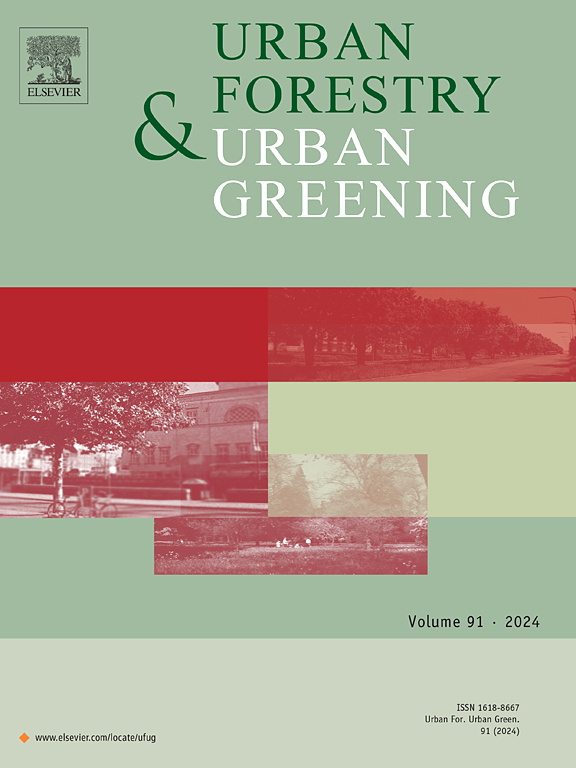校园景观如何影响大学生的恢复性体验:来自同时收集的生理和心理数据的证据
IF 6
2区 环境科学与生态学
Q1 ENVIRONMENTAL STUDIES
引用次数: 0
摘要
人们普遍认为,“待在大自然中”有益于身心健康。校园景观环境,简称“校园景观”,对学生的心理健康有着至关重要的影响。它为大学生提供了寻求放松和娱乐的户外空间,但它仍未得到充分研究。在本研究中,我们利用现场步行实验同时收集的心理和生理数据,解决了静态评估校园景观恢复效果的局限性,并将重点从视觉扩展到非视觉和事件景观(n = 40)。本研究通过使用可穿戴传感器分析压力和注意力恢复,以及来自问卷调查和访谈的感知心理数据,研究了不同类型的校园景观如何影响大学生的恢复性体验。结果表明,不同校园景观的修复效果存在显著差异,并进一步表现为视觉景观、非视觉景观和事件景观的修复效果。我们有几个主要发现:(1)93 %的学生报告了中等以上的压力水平,72 %的学生经历了注意力疲劳,突出了对恢复性校园景观的强烈需求;(2)斑驳绿蓝景观的应激恢复效果最好,线性绿蓝景观次之,教学空间次之,而生活空间尤其是通勤路径的应激恢复效果最差,生理皮肤电活动(EDA)和心理知觉恢复量表(PRS)显示;同时,大多数被试在步行后经历了校园景观类型的注意恢复,有趣的是,主观自我报告数据(FS-14)与客观测试(DSB和TMTB)相比低估了其效果;(3)在视觉景观中,较低的景观分割、较少的建筑景观、设计良好的景观设施、丰富的水体、绿地和天空景观与较好的应力恢复显著相关;(4)热环境、声景观、嗅觉景观等非视觉景观,以及事件景观(偶发事件、阶段性事件和常规事件)也会影响校园景观的修复效果。校园景观的审美品质和娱乐活动的能力是学生恢复性体验的关键。因此,校园景观设计师应优先规划斑纹绿蓝空间,并在设计指南中同时考虑视觉、非视觉和事件景观,以改善大学生的心理健康。本文章由计算机程序翻译,如有差异,请以英文原文为准。
How does campus-scape influence university students' restorative experiences: Evidences from simultaneously collected physiological and psychological data
"Time in nature" is widely acknowledged as beneficial for physical and psychological health. The landscape environment of campus – referred to as "campus-scape" – plays a crucial role in influencing students’ mental health. It provides outdoor spaces where university students sought for relief and recreation, yet it remains under-researched. In this study, we address a limitation in the static assessment of restorative effects of campus-scape, and extend the focus from visual to non-visual and event landscape, using simultaneously collected psychological and physiological data from an on-site walking experiment (n = 40). This study examined how different types of campus-scape affect university students' restorative experiences by analyzing stress and attention restoration using wearable sensors, alongside perceptional psychological data from questionnaires and interviews. Our results revealed significant differences in the restorative effects of various campus-scape, and the influences were further characterized by visual, non-visual, and event landscape. We have several key findings: (1) 93 % of students reported above-medium stress levels and 72 % experience attention fatigue, highlighting a strong need for restorative campus-scape; (2) Patchy green-blue landscape performs best in stress recovery, followed by linear green-blue landscape and teaching spaces, while living spaces especially the commuting paths were the least restorative, as indicated by physiological electrodermal activity (EDA) and psychological perceived restorative scale (PRS).Meanwhile, most participants experienced attention restoration post-walk across campus-scape types, interestingly subjective self-reported data (FS-14) underestimated the effects compared with objective tests (DSB and TMTB); (3) Within visual landscape, lower landscape segmentation, fewer building views, more welldesigned landscape facilities, and abundant waterbodies, green, and sky views are significantly associated with better stress recovery; (4) Non-visual landscape like thermal conditions, soundscape, and olfactory landscape, along with event landscape–occasional, staged, and routine events–also influence the restorative effects of campus-scape. The aesthetic qualities of campus-scape and capacity for recreational activities are key to students' restorative experiences. Therefore, campusscape designers should prioritize the planning of patchy green-blue spaces and consider enhancing visual, non-visual, and event landscape simultaneously in design guidelines to improve university students' mental well-being.
求助全文
通过发布文献求助,成功后即可免费获取论文全文。
去求助
来源期刊

Urban Forestry & Urban Greening
FORESTRY-
CiteScore
11.70
自引率
12.50%
发文量
289
审稿时长
70 days
期刊介绍:
Urban Forestry and Urban Greening is a refereed, international journal aimed at presenting high-quality research with urban and peri-urban woody and non-woody vegetation and its use, planning, design, establishment and management as its main topics. Urban Forestry and Urban Greening concentrates on all tree-dominated (as joint together in the urban forest) as well as other green resources in and around urban areas, such as woodlands, public and private urban parks and gardens, urban nature areas, street tree and square plantations, botanical gardens and cemeteries.
The journal welcomes basic and applied research papers, as well as review papers and short communications. Contributions should focus on one or more of the following aspects:
-Form and functions of urban forests and other vegetation, including aspects of urban ecology.
-Policy-making, planning and design related to urban forests and other vegetation.
-Selection and establishment of tree resources and other vegetation for urban environments.
-Management of urban forests and other vegetation.
Original contributions of a high academic standard are invited from a wide range of disciplines and fields, including forestry, biology, horticulture, arboriculture, landscape ecology, pathology, soil science, hydrology, landscape architecture, landscape planning, urban planning and design, economics, sociology, environmental psychology, public health, and education.
 求助内容:
求助内容: 应助结果提醒方式:
应助结果提醒方式:


